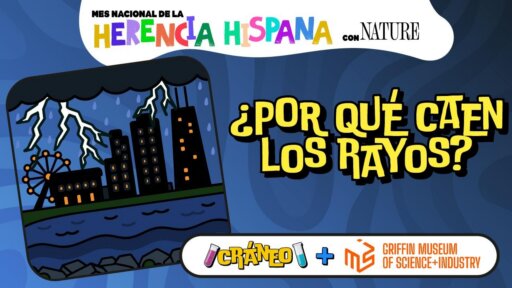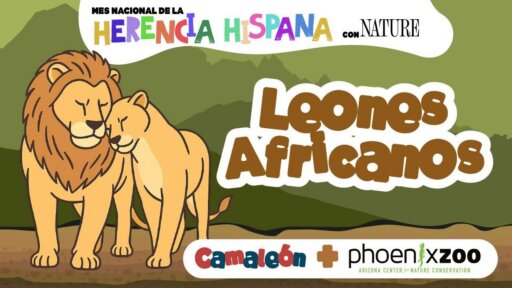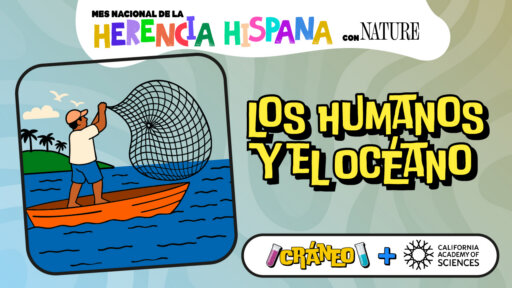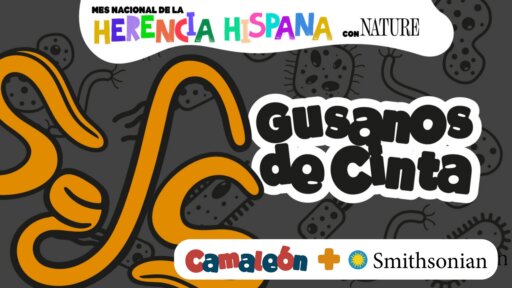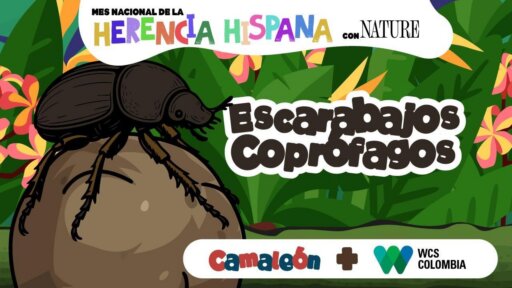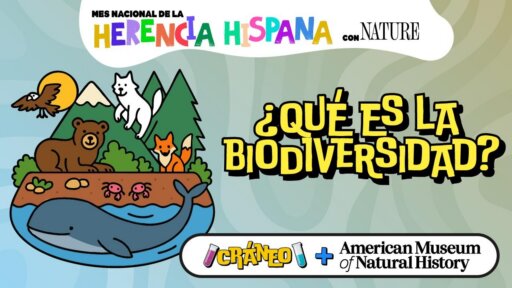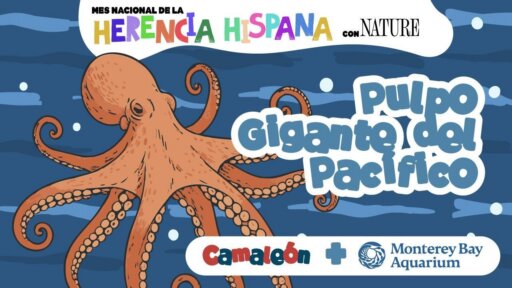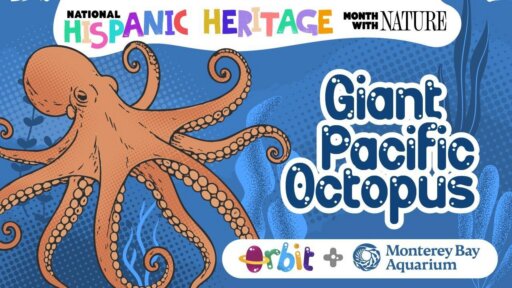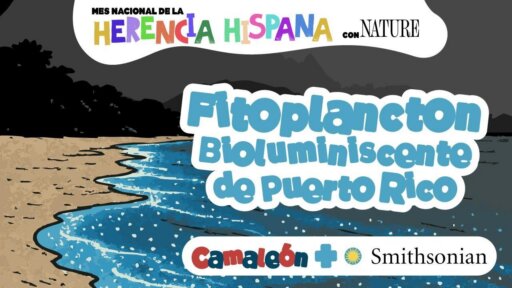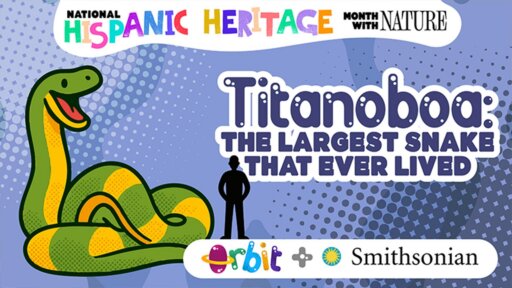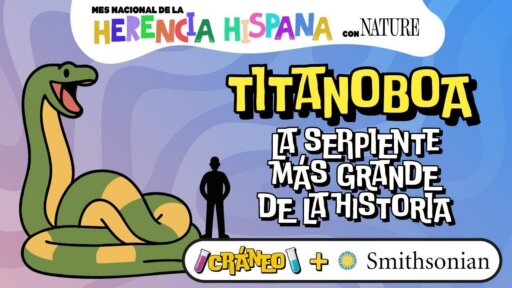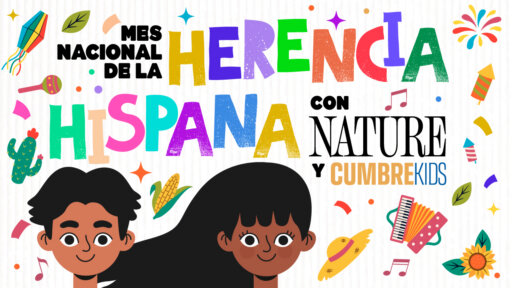TRANSCRIPT (EN)
00:00:00 Robert:
Hi there, Rob here.
00:00:02 Robert:
This episode is part of a bilingual children’s podcast series for National Hispanic Heritage Month, a collaboration between PBS Nature and Cumbre Kids.
00:00:10 Robert:
This series features scientists from leading museums, zoos, and aquariums across the United States, responding to questions submitted by listening children 3 to 10 years old.
00:00:20 Robert:
These episodes appear on the podcasts Orbit: Science for Kids on the Move, Cráneo: Ciencia para Niños Curiosos, and Camaleón: Animales para Niños Curiosos.
00:00:30 Robert:
They are podcasts for families with children 3 to 10 years old and can be found on YouTube, Spotify, Apple Podcasts, or wherever you listen to podcasts.
00:00:38 Robert:
Just a heads up, this episode is in Spanish.
00:00:41 Robert:
We hope you enjoy.
00:00:45 Katherin:
Hey! Who waaas that? Someone just threw a snowball right in my face… and now I can’t see anything! Look around you!
00:00:58 Katherin:
Everything is white, white, and more white, as if the world has lost all its colors, but even so, it’s beautiful. Now tell me, do you know where this snow comes from?
00:01:12 Kids:
Hi, I have a question for the scientist.
00:01:16 Kids:
Why is snow white?
00:01:19 Kids:
How can so much snow build up in the sky?
00:01:23 Kids:
Why is snow important for the planet?
00:01:26 Katherin:
Alright friends, today is the perfect day to cool off our brains a little… with some cold science!
00:01:34 Katherin:
Have you ever wondered why everything looks so bright when it snows — so bright it even hurts to look? Where does the snow go? Why is it white? And so much more. Are you ready to meet our guest today and learn about this amazing white world? Let’s go!
00:01:57 Mónica Zapata:
Hello, Cráneos! How are you? I’m so excited to be here with you. My name is Mónica Zapata, and I’m an environmental scientist.
00:02:02 Katherin:
Scientist Mónica studies snow, glaciers, and how they change with the climate.
00:02:13 Mónica Zapata:
I studied chemical engineering, and now I’ve researched snow in burned forests and surprising things that happen in nature.
00:02:21 Mónica Zapata:
I collaborate with an institution on the Oregon coast, taking care of water and land, and before that, I was part of a snow laboratory at Portland State University.
00:02:32 Katherin:
Wow, Cráneos! Can you imagine everything Mónica has discovered? She knows so much about snow that today she’ll be our guide on this journey. She’ll help us answer a bunch of questions that you sent in. But first, let’s go back to the basics… What is snow, really?
00:02:52 Alina:
Hi, my name is Alina. I live in California, and my question is: what is snow?
Hi, Cráneos, how are you? I’m Antonio Morales Ramos, and I live in Cali, Colombia, and my question is: what is snow and where does it come from?
Hi, I’m Luciana, I live in Toluca, Mexico. I’m 7 years old, and my question is: how can so much snow build up in the sky?
00:03:26 Mónica Zapata:
Ok, excellent question! Snow is water, but you imagine it in the form of tiny frozen flakes.
00:03:35 Mónica Zapata:
When the air is very cold up in the clouds, water vapor turns into tiny ice crystals. These crystals come together and form snowflakes. Each flake has a unique shape, like a jewel made of ice. When there are lots of flakes together, we have a snowfall. So snow is born in the clouds, travels through the air, and reaches the ground as soft as a cold pillow.
00:04:04 Katherin:
In other words, snow appears because the clouds are so cold that the water vapor can no longer stay as a gas, so it freezes into crystals. Those crystals join together into tiny flakes. We can imagine the clouds like a giant factory.
00:04:29 Katherin:
Inside this factory, the droplets of water freeze, stick to each other, and form little flakes. While they are light, the air can hold them up, but when there are too many, they get heavy. The clouds can’t hold them anymore, and that’s when the snowfall happens.
00:04:53 Katherin:
And before we move on to more questions, let’s sharpen our ears.
00:04:59 Katherin:
Listen carefully, because this is the mystery sound.
00:05:09 Katherin:
Listen one more time.
00:05:17 Katherin:
Here are the options:
A. It’s a hand saw.
B. It’s a car starting.
Got it? Keep your answer until the end.
00:05:34 Katherin:
I want to remind everyone about our sister podcast Camaleón: Animales para Niños Curiosos. It’s a fascinating podcast to learn all about animals. I’ll leave the link in the description of this episode.
00:05:50 Eyre:
Hi, I’m Eyre, I’m 7 years old and I’m from Bilbao, Spain, and my question is: why do I have to wear sunglasses when I go to the snow?
00:05:59 Nicolás:
Hi Cráneos, my name is Nicolás, I’m 8 years old and I live in Puerto Morelos, Mexico, and my question is: how does snow reflect the sunlight? Thank you.
00:06:10 Clemente:
Hi, I’m Clemente, I’m 8 years old and my question is: I had never heard about the albedo effect — can you tell me how it works? Bye Cráneo, greetings to Kat.
00:06:27 Vicente:
Hi, I’m Vicente, I’m 5 years old and I live in Medellín, Colombia.
My question is: why does the white color of snow reflect sunlight? Bye, Cráneos.
00:06:41 Mónica Zapata:
Very important and super interesting. Snow isn’t just white, it’s shiny — like a magical mirror.
00:06:49 Mónica Zapata:
When the sun shines on snow, that light doesn’t just stay there, it bounces off. This is because of the albedo effect, which is the scientific name for how much a surface reflects sunlight.
00:07:04 Katherin:
Alright, Cráneos, let’s make a mental note of a couple of important things scientist Mónica just said:
Snow is so bright that it reflects light like a mirror.
This reflection has a scientific name: albedo effect, and it means how much light bounces off a surface.
00:07:30 Mónica Zapata:
Snow has a very high albedo, which means it reflects almost all the sunlight it receives. Imagine you’re standing on a carpet made of millions of icy mirrors — that light bounces straight into our eyes.
00:07:46 Mónica Zapata:
And it can be so strong that it dazzles us, which is why we wear sunglasses, even when it’s cold, to protect our eyes. The more snow there is, the more light is reflected back into space, helping the Earth stay cooler. But if the snow melts, the dark ground absorbs more heat — and that can speed up climate change.
00:08:09 Katherin:
Wow! It’s incredible to know that snow can help cool the planet, and also that when it melts, it can increase the heat. But that brings up another big question…
00:08:21 Katherin:
If snow is made of water, why do we see it as white?
00:08:26 Luca:
Hi, I’m Luca, I’m 6 years old, and I live in Venezuela. My question is: why is snow white?
Hi, I’m Santiago, I’m from Colombia, I’m 5 years old, and my question is: why is snow white?
00:08:51 Mónica Zapata:
Good question, Luca and Santiago. So, snow looks white, but it actually doesn’t have that color. What happens is something scientific. Each snowflake is made up of ice crystals with many shapes and tiny air pockets. When sunlight, which has all the colors like a rainbow, hits those crystals…
00:09:16 Mónica Zapata:
The light scatters. That means it bounces off in many directions.
00:09:22 Mónica Zapata:
Since all the colors of the sunlight bounce at the same time…
00:09:27 Mónica Zapata:
Our eyes see them all mixed together, and that looks white. So snow isn’t white because it has color — it’s white because it reflects all the light, like a carpet made of millions of tiny icy mirrors.
00:09:43 Katherin:
I know, it sounds hard to imagine, but think about a waterfall or whipped egg whites — they also look white.
00:09:54 Katherin:
The same thing happens with snow because sunlight has all the colors of the rainbow, and when they all bounce together into our eyes, our brain mixes them and we see it as a bright white.
00:10:10 Katherin:
And if you want to test this yourself, there’s a really fun experiment. You’ll need three flashlights and colored cellophane paper: one red, one blue, and one green. If you put a piece of colored cellophane over each flashlight and then point all three lights at the same spot on the wall…
00:10:29 Katherin:
Surprise! The colors will mix together, and you’ll see an almost white light.
00:10:37 Katherin:
This makes me think of something else. I’ve heard that snow isn’t always white — it can even appear in other colors. Could that be true? Why does that happen? And what can make snow change color?
00:10:51 Mónica Zapata:
Yes, yes, it can change color. Sometimes snow can be black, dark, gray, or even pink.
00:11:00 Mónica Zapata:
Why? It can be because it has dust — this can come from ashes or even from wildfires.
00:11:08 Mónica Zapata:
So, imagine there’s a forest fire, and then when the snow falls afterward, the snow will turn black because of the fires that bring ashes. For example, the smoke and charcoal travel with the wind and fall on the snow. That charcoal stays trapped there, as if the snow were holding onto a trace of the fire. This is very important because dark snow absorbs more heat.
00:11:34 Mónica Zapata:
It melts faster, and that changes entire landscapes.
00:11:40 Katherin:
Cráneos, so snow doesn’t just change color — it can also hold stories of the place where it fell, like ashes from a wildfire or dust that traveled with the wind. This isn’t a small detail! Remember what we learned about the albedo effect: if the snow is clean and shiny, it reflects a lot of light.
00:12:03 Katherin:
And that helps cool the planet. But if it’s darkened by dust or charcoal, it reflects less light, absorbs more heat, and melts more quickly. That’s why scientists like Mónica study snow — because by observing these changes, we can better understand how the Earth is responding to the climate and how those tiny snowflakes affect the entire planet.
00:12:30 Katherin:
This reminds me of a story about a scientist who changed the way we understood the polar climate.
00:12:37 Mónica Zapata:
Get ready for a trip back in time.
00:12:43 Katherin:
3, 2, 1… traveling…
00:12:51 Mónica Zapata:
More than 100 years ago, a brave scientist named Nils Ekholm traveled to the Arctic — to a super icy and isolated place — to understand the climate. Imagine Nils in his wooden cabin.
00:13:07 Mónica Zapata:
Surrounded by ice, taking notes with thick gloves.
00:13:12 Mónica Zapata:
And watching the ice day after day.
00:13:14 Katherin:
Cold wind blowing hard, snow falling, and a deep silence where you could hear the ice creaking.
00:13:26 Mónica Zapata:
Nils didn’t go there just for the thrill. He wanted to measure and was very interested in the polar climate.
00:13:34 Katherin:
So he brought scientific instruments to observe the temperature, wind, pressure, air, and ice thickness. Day after day and night after night, he wrote down everything he saw and felt, as if he were having a conversation with the ice.
00:13:53 Mónica Zapata:
What he discovered was very interesting.
00:13:56 Mónica Zapata:
The ice was changing, and his notes became some of the very first evidence that if the polar ice were to melt — imagine what could happen — the Earth could heat up much faster. That’s because the white ice, which normally reflects sunlight thanks to the albedo effect, disappears, and the dark ocean absorbs more heat.
00:14:21 Katherin:
His discoveries planted the seed for what we now know as the science of climate change.
00:14:29 Mónica Zapata:
And it all began with a curious, brave, and very well-bundled-up man.
00:14:34 Mónica Zapata:
Who listened to the whispers of the ice and taught us to take care of our planet.
00:14:40 Nil y Ona:
Hi, Cráneos.
00:14:43 Kids:
We are Nil and Ona, we live in Barcelona, Catalonia, we are four and six years old, and our question is: why does snow melt?
00:14:55 Paula:
Hi, I’m Paula, I’m 9 years old, and I live in León, Guanajuato.
00:14:59 Paula:
And my question is: what happens when snow melts? Bye!
00:15:04 Mónica Zapata:
Of course! Hi Nil, Ona, and Paula, thank you for the question. Snow melts when the air temperature rises.
00:15:14 Mónica Zapata:
This happens with the arrival of the sun, heat, or when the seasons change. It’s like when you leave an ice cream out of the freezer — little by little, it turns into water. When snow melts too quickly, the water rushes down the mountains like a slide and can fill rivers so fast that it causes major flooding.
00:15:38 Mónica Zapata:
But if there isn’t enough snow, then later on there won’t be enough water.
00:15:44 Mónica Zapata:
Did you know that many cities use snowmelt water for drinking, cooking, or watering crops?
00:15:52 Mónica Zapata:
Snow is like a giant bottle of fresh water stored in the Earth’s freezer. If it melts all at once, the humans, animals, and plants that depend on it would be in trouble. That’s why it’s so important to care for the snow and keep our planet cool and beautiful.
00:16:11 Katherin:
How interesting what Mónica just told us, Cráneos! Notice this: when snow melts, it’s not just the water people use that changes — an entire ecosystem changes too. For example, that water feeds rivers where fish live.
00:16:29 Katherin:
It helps plants grow in the spring, and it’s essential for animals like beavers, who need water to build their homes. Snow acts like a great guardian of fresh water, storing it in the mountains and releasing it little by little so the whole ecosystem can live in balance. And now comes a very special question.
00:16:55 Katherin:
What kinds of scientists study snow, and how could we be part of that research in the future?
00:17:04 Mónica Zapata:
Okay, Cráneos, so the scientists who study snow are called…
00:17:10 Mónica Zapata:
Nivologists or glaciologists — remember those names.
00:17:14 Mónica Zapata:
There are also meteorologists, ecologists, and even engineers who work with snow.
00:17:23 Mónica Zapata:
If you want to become one, you can start right now — by asking questions!
00:17:29 Mónica Zapata:
By observing, reading, drawing snow and mountains, and even dreaming! At school, pay close attention to science, math, and geography. And also play outside whenever you can. In the future, you could go on expeditions to the mountains, use drones or satellites, and help the planet.
00:17:53 Mónica Zapata:
Because science needs curious minds like yours and mine.
00:18:01 Katherin:
I love that, Mónica. Did you hear that, Cráneos? Becoming a scientist doesn’t start on a mountain — it starts right here with curiosity. Every question you ask today brings you closer to that future.
00:18:18 Mónica Zapata:
Thank you, Cráneos. Thanks to everyone for your questions — I loved them! Never stop asking questions, never stop exploring with enthusiasm.
00:18:27 Mónica Zapata:
And never stop taking care of this beautiful planet.
00:18:30 Mónica Zapata:
Love the water that gives us life, the sun that warms us, and the snow that holds many stories from the past. Love the glaciers that protect the Earth, and all the living beings we share this home with. And remember: science isn’t just for people in white lab coats — it’s for all children who dream big, observe the world with curiosity, and want to protect nature with love and courage.
00:18:57 Katherin:
Thank you, Mónica! Cráneos, today we learned that snow holds the Earth’s secrets and that science begins with something very simple: asking questions and observing with curiosity.
00:19:10 Katherin:
Now, Cráneos, let’s listen carefully — it’s time to reveal the mystery sound. Here it goes.
00:19:24 Katherin:
One more time.
00:19:31 Katherin:
Here are the options:
00:19:34 Katherin:
A. It’s a hand saw.
B. It’s a car starting.
Do you have it? It was a hand saw — very good!
00:19:48 Katherin:
Now, Cráneos, it’s time for special shout-outs!
Happy birthday to our Cráneo, Alex Salinas, who loves cats and listens to us from Monterrey, Mexico.
00:20:03 Katherin:
Happy birthday also to Miranda, who loves sloths and listens to us from Minneapolis in the United States.
Happy birthday, my dear Cráneos — we send you a gigantic hug!
And greetings as well to our friends Joel Matoma Ramírez in Bogotá, Colombia. And of course, a special greeting to Sofía.
00:20:29 Katherin:
Who listens to us from Mexico City. As always, thank you for listening and for being part of this Cráneo family.
00:20:38 Katherin:
And now, my dear Cráneos, we’ve reached the end of this episode. Cráneo is a production of Cumbre Kids.
Robert Carpenter is our executive producer, Moisés Monsalve is our graphic artist, Jorge Cedillo is our illustrator, and I am Katherin Aguilar, producer of this podcast.
We’ll be back next week with a brand-new episode.
00:21:05 Katherin:
Until then, keep your curiosity alive!

